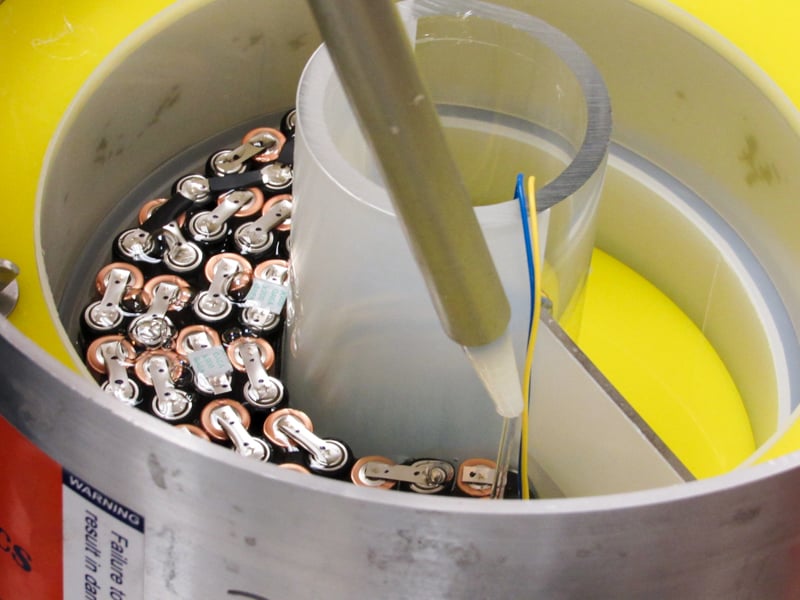Consumers use battery packs for devices used in diverse environments. While the ideal device would experience cool temperatures without drastic temperature changes and be free from corrosion, chemicals, water, shocks, and vibrations, this setup is not always the case. Some devices used in chemical manufacturing processes may experience chemical exposure. Other devices used outdoors may have to deal with harsh temperatures and an abundance of moisture.
All of these factors may have detrimental effects on the battery pack. Corrosion, chemicals, water, and fluctuating temperatures may cause minor to significant damage or malfunctions to the battery pack. Vibrations or shocks may loosen or damage electrical connections for the pack. In addition, these issues could shorten the battery life.
Customers looking for a custom battery pack design may select battery potting during the manufacturing process. Battery potting involves fully or partially placing a compound around the batteries that are set in the mold.
Battery Potting Characteristics
Potting involves using a mold that holds the batteries in place for the application of the potting compounds. All electrical connections and the battery management system (BMS) are put into place, tested, and verified before the potting process, as they may not be changed if the battery pack undergoes full potting encapsulation.

Custom battery pack during potting and encapsulation process.
The potting compounds derive from acrylic, epoxy resin, polyurethane, and silicone. The type of compound used for the battery pack potting is dependent on knowing the operating conditions of the application as well as the physical properties of the materials, environmental conditions, and the processing requirements.
- Silicone: Silicone offers temperature resistance for both extremely hot and extremely frigid conditions. It is considered the most expensive option for potting.
- Acrylic: Acrylic hardens quickly and provides chemical resistance. It typically has a higher cost than other compounds. There is a limit to how thick the acrylic can be.
- Epoxy: Epoxy provides heat resistance and chemical resistance while providing medium-hard protection. The epoxy may become damaged from impacts.
- Polyurethane: Considered one of the least expensive options available. Softer than other potting compounds with a high resistance to degradation to temperatures over 200°
These compounds come with different hardness and softness levels. They may also possess varying capabilities such as flame retardancy, thermal stability, heat dissipation, and dielectric strength enhancements.
Battery Pack Potting Process
Watch this short video to learn more about what is involved in the potting process of a custom battery pack.
Applications Requiring Potting
Battery potting applications will vary based on the device and industry. Batteries experiencing marine conditions with excessive moisture and saltwater exposure on docks and boats would undergo battery potting.
Control panels and devices experiencing extreme and rapidly fluctuating temperatures, such as in airplanes and military aircraft applications, may find benefits with the battery potting as the battery pack would be more protected and undergo fewer temperature fluctuations.
Any devices that may experience shock and vibrations, from dropped cell phones, batteries in electric vehicles, wheelchair batteries, video camera battery packs, laptop computers, and portable devices may become potted to absorb the vibrations and shocks.
Battery Chemistries for Potting
Both lithium-based batteries and alkaline batteries may undergo potting. These battery chemistries experience little off-gassing that would build up within the battery if they become encased with potting compound.
Nickle-based batteries, such as nickel-cadmium (NiCAD) do require vents to allow the gases to be released. They may be potted yet should not undergo total potting that would cover over the vents. Larger lithium-ion batteries, such as ones used in hybrid vehicles, would also require venting designs. Potting may be used for primary and secondary batteries.
In addition, other electronics such as the BMS also may undergo the potting process. The compounds extend their protective capabilities over to the BMS system while the system continues to perform its functions by monitoring the state of health (SoH), state of charge (SoC), battery temperature, and other features of the battery pack.
Potting Boxes
Potting compounds come in different colors as well as clear resins. The customer may select certain colors based on the battery pack's specifications and specific devices it may be used in. These compounds are not always hard. Due to the battery pack experiencing expansion and contraction, the compounds also need to allow for expansion and contraction as they will range from a medium-hard to medium-soft texture.
The potting compound may become damaged if used strictly as the enclosure for the battery pack. Also, it may have too soft of a composition to protect the battery pack during use for applications that may experience shocks and vibrations. Potting boxes are used to hold the compound and work as an enclosure. These potting boxes may come in varying materials, such as ABS plastic or even diecast aluminum. With the potting box, the potted battery can handle transportation and handling.
Benefits of Potting a Battery Pack
Potting batteries provides a range of benefits for the battery pack and the application. The compounds provide a type of hermetic seal preventing anything from penetrating. It wards off chemicals, moisture, and temperatures. Depending on the type of compound it is, the materials may also draw away and disperse the heat created from the battery pack, allowing for the cells to remain within normal temperature operating ranges.
In addition to keeping moisture, chemicals, and extreme temperatures from the batteries, the potting compounds may also provide different cured properties. They may offer enhanced dielectric strength and electrical insulation for the battery pack. They keep attached electronics in place even when the battery pack becomes dropped or experiences other shocks and vibrations.
Potting shells are also lower in cost. Since the potting compounds will partially or fully fill the potting box, it provides additional strength and protection. So, the potting shell or box does not need to have an extra thickness added.
Battery potting is available for battery cells of different sizes and configurations. With potting, customers gain peace of mind that their battery packs are further protected from environmental conditions, operating conditions, and other adverse factors.
Summary
Customers should keep in mind that battery potting is not a standard requirement for all battery packs. It is an available option when the battery pack will experience certain conditions that require extra protection within the device. The potting timeline will depend on the type of compound that is selected along with its curing requirements. The timeline also depends on the availability of the compound for prototyping and battery pack manufacturing.
By going over the battery chemistry and characteristics, the customer may have a clearer understanding of what potting compounds offer the desired properties at an acceptable price for the budget. Then the manufacturer can create the tooling and samples for the customer to evaluate within the device itself. The customer may make any changes to the specifications for the prototypes until an agreement is reached for the battery chemistry, potting materials, and any additional electronics required. Then the manufacturing process can proceed for the battery packs.
Key Takeaways
- Pressure equalization: Vent tubes are added to multi-conductor cables to help equalize pressure in sealed enclosures exposed to cyclic heating, cooling, or outdoor environments, preventing damage to sensitive components like diaphragms, seals, and keypads.
- Design considerations: Adding a vent tube increases cable stiffness and can reduce flexibility, so engineers must carefully consider bend radius limits and ensure the tube does not kink or block airflow.
- Airflow challenges: Vent tubes are subject to head loss (pressure drop due to friction), which depends on the tube’s diameter, length, and material smoothness. If undersized, airflow may be too restricted to be effective.
- Material requirements: Vent tubes are typically made from thermoplastics like polyethylene or TPE with a minimum 0.020" wall thickness. They must also comply with UL flame ratings, such as VW-1, for safety and regulatory approval.
- Customization options: Vent tube cables can be UL-rated and tailored with different jacket materials, shielding, colors, and sizes, making them a cost-effective solution for applications requiring venting while maintaining electrical performance.
















